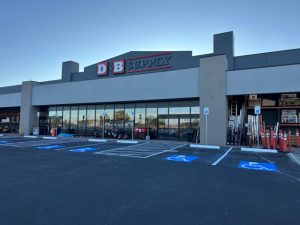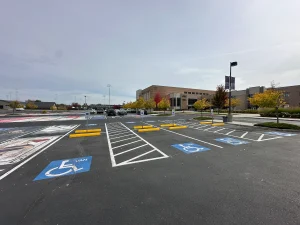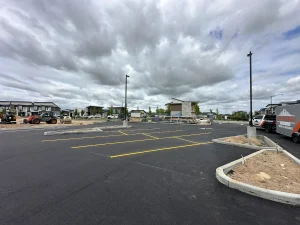Choosing the Right Paint for Parking Lot Striping
Parking lot striping is essential for creating a well-organized, safe, and visually appealing space. Whether it’s defining parking spaces, marking traffic flow, or designating accessible zones, clear and durable striping ensures that your parking lot functions properly. However, one factor that’s often overlooked is the type of paint used for striping. Not all paints are created equal, and selecting the right paint can make a significant difference in the longevity and visibility of your parking lot markings. Here’s why choosing the right type of paint for parking lot striping is so important and how it affects both the appearance and performance of your parking lot.
1. Durability and Longevity
One of the primary reasons to invest in high-quality paint for parking lot striping is durability. Parking lots are subject to heavy vehicle traffic, weather exposure, and general wear and tear, all of which can cause paint to fade or chip over time. Using a paint that is specifically designed for asphalt or concrete surfaces ensures that your striping will last longer, reducing the need for frequent touch-ups.
The right paint can withstand:
- Temperature Extremes: Hot summers and freezing winters can cause poor-quality paint to crack, peel, or fade quickly. High-quality striping paints are formulated to expand and contract with temperature changes, maintaining their integrity in harsh climates.
- UV Exposure: Constant exposure to the sun can cause paint to fade or discolor over time. UV-resistant paint maintains its vibrant color, ensuring that markings remain clear and visible for longer.
- Heavy Traffic: Parking lots experience constant vehicle traffic, which can quickly wear down paint. Durable striping paint resists abrasion from tires, keeping the lines and markings intact for extended periods.
Investing in the right paint upfront can save you money in the long run by reducing the frequency of repainting and maintaining the appearance of your parking lot.
2. Visibility and Safety
The primary function of parking lot striping is to clearly communicate information to drivers and pedestrians, including parking spaces, directional arrows, crosswalks, and fire lanes. For these markings to be effective, they need to be highly visible—especially in low-light conditions or at night.
- Reflective Paint: In many cases, reflective paint is the best choice for parking lots, especially those that are used after dark. Reflective striping paint contains tiny glass beads that reflect light from headlights, making the markings easier to see at night and improving overall safety.
- Bright Colors: The color of the paint also plays a crucial role in visibility. Yellow, white, and blue are commonly used for parking lot striping because they provide high contrast against the black surface of asphalt. Specialty paints designed for striping are formulated to retain their brightness even after extended exposure to weather and traffic.
Using high-visibility paint ensures that drivers can easily navigate the parking lot, reducing the likelihood of accidents, confusion, or violations of parking rules.
3. Compliance with Regulations
When striping a parking lot, it’s important to follow federal, state, and local regulations—especially when it comes to ADA compliance. The Americans with Disabilities Act (ADA) requires specific markings for accessible parking spaces, including designated areas for van-accessible spots, clear access aisles, and proper signage.
The type of paint used for these markings is just as important as the design:
- Blue Paint for Accessible Spaces: ADA regulations require that accessible parking spaces be marked with blue paint, which is highly visible and associated with accessibility.
- Durability Standards: The ADA also specifies that markings must remain clearly visible and legible. Using a durable, weather-resistant paint ensures that your parking lot remains compliant and avoids potential fines or legal issues.
In addition to ADA compliance, other local regulations may dictate the use of specific colors or materials for fire lanes, no-parking zones, and other safety-related markings. Selecting the correct paint ensures that your parking lot meets all necessary legal requirements.
4. Cost-Effectiveness
While cheaper paints may seem like a cost-saving solution, they often result in higher maintenance and re-striping costs over time. Low-quality paints fade faster, chip more easily, and may need to be reapplied frequently, leading to higher long-term expenses.
- High-Quality Paint Reduces Maintenance: Investing in premium paint initially may have a higher upfront cost, but it can significantly reduce the frequency of re-striping. High-quality paint lasts longer and requires less upkeep, making it a more cost-effective choice in the long run.
- Weather-Resistant Paint Saves Money: Parking lots are exposed to a wide range of weather conditions, from scorching heat to freezing temperatures. Choosing weather-resistant paint ensures that your parking lot striping remains intact despite harsh conditions, avoiding the need for frequent re-striping and touch-ups.
Ultimately, selecting the right paint is a smart financial decision that protects your investment in parking lot maintenance.
Conclusion
The type of paint used for parking lot striping is more than just a cosmetic choice—it plays a crucial role in the functionality, safety, and longevity of your parking lot. Durable, high-visibility, and regulation-compliant paint ensures that your lot remains safe, well-organized, and cost-effective. By investing in high-quality paint, you can reduce long-term maintenance costs, improve safety for drivers and pedestrians, and maintain a professional appearance for your property. When it comes to parking lot striping, the right paint makes all the difference.


